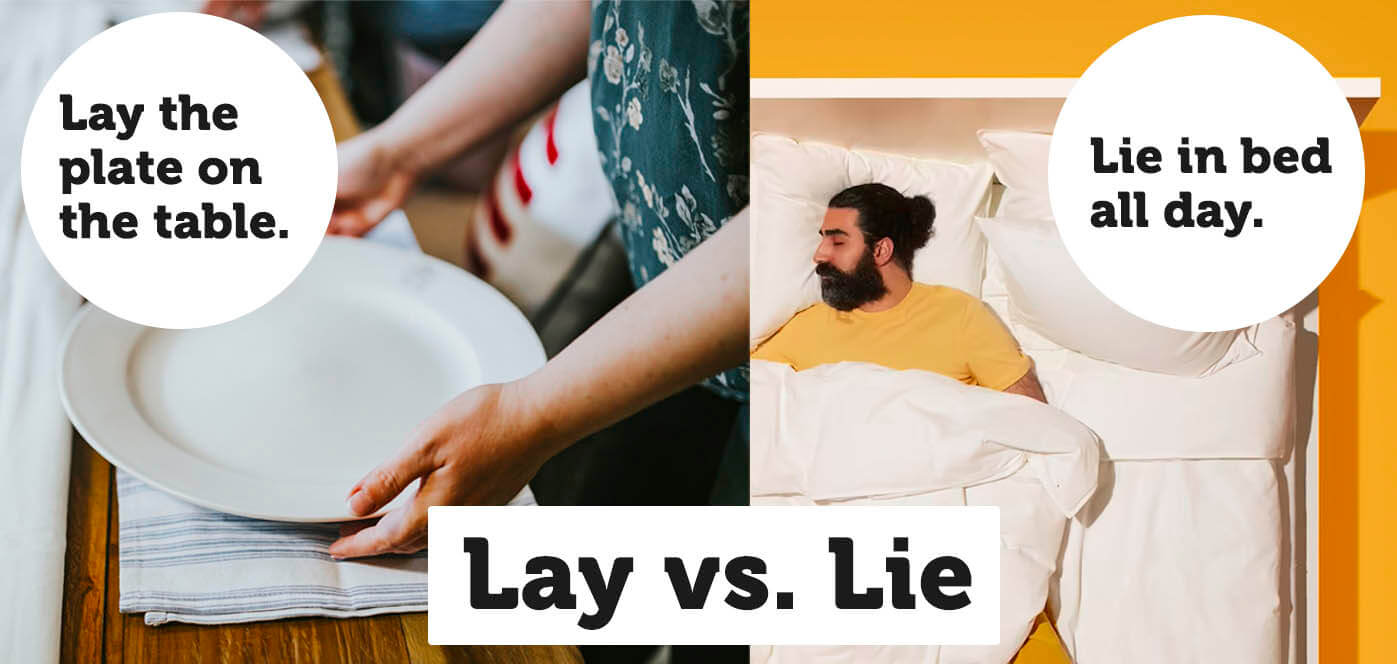Lay and Lie are both verbs (actions). They have similar meanings, but lay means ‘put something on a surface carefully’ – e.g. Chloe lays her clothes on the bed. Lie means ‘move into a horizontal position (independently)’ – e.g. Sarah lies on the sofa after work. Simple rule: Lay (put something down flat) vs. Lie (get into a horizontal position).
Warning! We are not talking about the verb lie that means ‘to tell an untruth’. Here, we are only interested in lie – movement into a horizontal position.

The main thing to think about when using lay or lie is that lay needs a direct object (it is an action that affects a thing) – e.g. The waiter laid the cutlery on the table. The direct object is the cutlery, which is laid on the table. In contrast, lie does not need a direct object – you don’t need anything extra to lie on a bed (you do it independently yourself) – e.g. Dave was looking forward to lying on the beach.
Another way to think about lay and lie is that if you use lay, there is almost always a thing that follows after it plus a preposition (down, on, in, aside, next to) – e.g. Denise forgot to lay her glasses on the bedside table. Lie, on the other hand, is always followed by a preposition – e.g. When John feels ill, he lies down.
If direct objects and prepositions make your head hurt, try remembering these two patterns for lay and lie:
*With lay, there is not always a somewhere that follows the something – e.g. The gallery owner laid the drawings out for the client. But most of the time there is a specific location.
Lay and lie can be more confusing when we look at them in different tenses:
| Time | Lay | Lie |
| Present | The correct way is to lay the fork to the left of the plate… | The cat likes to lie next to the window.
|
| Past | Kerry laid the keys on the sideboard. | John lay in bed all day. |
| Past Participle | The shop assistant has laid the sale items near the entrance. | Has Peter lain in the sun too long? |
| Present Participle | Are you laying out the dinner plates? | Teresa is lying on the lawn. |
Most of the confusion comes from the present form of lay (lay) being the same as the past form of lie (which is also lay!).
Below are some correct and incorrect ways to use lay and lie in the present and the past:
Another common mistake that people make is to use the past tense of lay (laid) instead of the past tense of lie (lay) – some people even make lay into a regular verb by saying layed (incorrect form).
There are similar errors with the present participle. Some people mistakenly use laying instead of lying.
Again, even when we consider different tenses, the easiest rule to use when thinking about lay vs. lie is: we lay something (somewhere), but we lie down somewhere (ourselves).
Lay (transitive verb) means: ‘To put something on a surface carefully’.
Synonyms: put down, place, set.
Set expressions: lay something bare (to expose something completely), be laid up (to be inactive due to illness or injury), lay something to rest (to succeed in resolving an issue, emotional state or argument).
Additional meanings:
Examples with lay in a sentence:
Lie (intransitive verb) means: ‘to move into a horizontal position’.
Synonyms: recline, rest, lounge.
Set expressions: Have a lie in (sleep later than usual), let sleeping dogs lie (not interfere in a situation), take something lying down (accept something negative without reaction).
Additional meanings:
Examples with lie in a sentence:
Try these exercises to test your understanding of the frequently confused words – lay and lie. You will have to think about tenses a lot so keep checking the table above to see which form you need to use!
Answers: